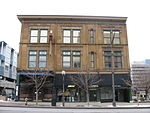Three Nationwide Plaza

Three Nationwide Plaza is a 408 ft (124 m) postmodern highrise building located at the address 3 Nationwide Plaza in Downtown Columbus, Ohio. The building is part of the larger multi-building complex known as Nationwide Plaza. Nationwide Plaza is the headquarters of Nationwide Mutual Insurance Company. Three Nationwide Plaza is the 10th tallest building in Columbus. Construction on the building finished in December 1988. The architect responsible was the NBBJ Group and the building design follows a postmodern style. The building was constructed for approximately $89 million and the main materials used were glass, steel, and precast concrete panels. The buildings that make up Nationwide Plaza are: One Nationwide Plaza, completed in 1977 280 Plaza (also known as Two Nationwide), completed in 1981 Three Nationwide Plaza, completed in 1988 Four Nationwide Plaza, completed in 2000
Excerpt from the Wikipedia article Three Nationwide Plaza (License: CC BY-SA 3.0, Authors, Images).Three Nationwide Plaza
North Front Street, Columbus
Geographical coordinates (GPS) Address External links Nearby Places Show on map
Geographical coordinates (GPS)
| Latitude | Longitude |
|---|---|
| N 39.9672 ° | E -83.0029 ° |
Address
Three Nationwide Plaza
North Front Street 3
43215 Columbus
Ohio, United States
Open on Google Maps










